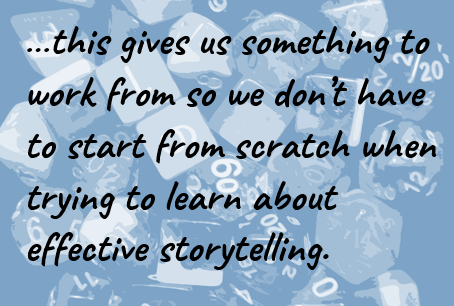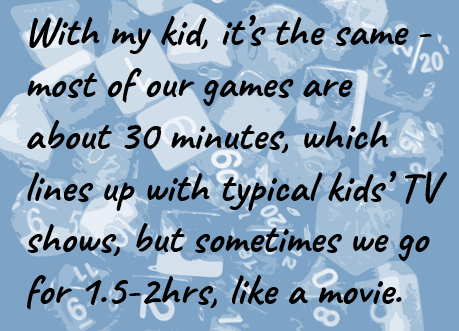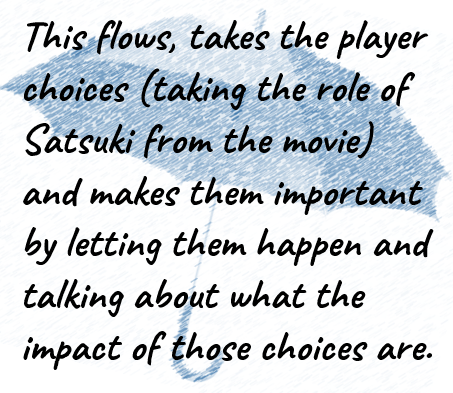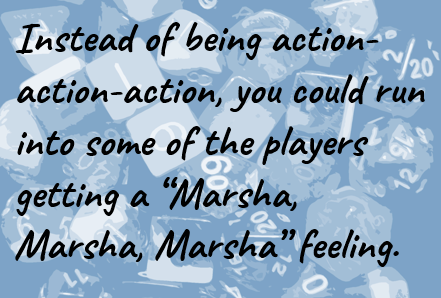Tips and tricks for pacing tabletop RPGs for kids
Jump to:
- Take a look at existing references
- Set an overall time frame
- Balance action and downtime
- Rotate the spotlight
- Final thoughts
Take a look at existing references that can apply to pacing your kid’s tabletop RPG

For most of this article, I am going to frame each point as a reference or analog to media that your players consume outside of tabletop RPGs because, especially for first time tabletop RPG players, it is a really good comparison point.
By no means do you need to stick to a rigid formula from your kid’s favorite TV show or something, but this gives us something to work from so we don’t have to start from scratch when trying to learn about effective storytelling.
So, to establish our foundation, for whatever age range your players are, think about what kind of media they consume. Is it short 15-30 minute TV shows? 2 hour long movies? Movie marathons (i.e. Lord of the Rings day)? Module or serial TV shows and movies? Podcasts? Short stories? Chapter books? Graphic novels? Video games? Anything else you can think of?
List some of their favorites that you think would line up well with a tabletop RPG style story, and then keep these in mind for the rest of the article.
Set an overall time frame to help pace your tabletop RPG session
Now that we have our list, consider, how long do your players engage in that media? Do they read for 10 minutes or could they go for hours? Do they want to watch 4 episodes in a row or do they lose interest and want to change to something else after the first one?

This gives you a base to work from when trying to determine how long your session should be. If you know that your kid will engage with some form of media for a couple hours, then it’s totally worth trying for a 2 hour game session. However, if you know they usually get bored with movies 30 minutes in and ALL of their shows are 30 minutes max, that’s probably a better starting point until you can try out tabletop RPGs with them a bit more.
When I plan sessions with my adult players, I usually keep them around 2 hours with some special one-shots going up to about 4 hours, because I know that that’s about everyone’s attention limit, and that lines up with the length of movies we watch (typically, they end at or before 2hrs, and sometimes, we’re OK to do a little marathon for a movie series). With my kid, it’s the same – most of our games are about 30 minutes, which lines up with typical kids’ TV shows, but sometimes we go for 1.5-2hrs, like a movie.
I do recommend erring on the safe side with shorter sessions or being flexible to know you may need to end your story early, especially when tabletop RPGs are new. If you plan for a 30 minute session and your kids are still into it, you can always stretch it a little with improv or plan for longer next time.
Balance action and downtime in your tabletop RPG to pace excitement and mood
Figuring out your overall time frame helps you to get the big picture for your game – now we want to start getting to the in-game details by creating some action and downtime balance.
If you have action-action-action-action planned for your game, that can sometimes be fun, but it can also sometimes be either very draining or too exciting. Think of it like one of those kids’ TV shows where it’s 15 minutes straight of bombastic and exciting events and flashing lights and colors and… by the end, I know my kid is either all riled up and running around copying it or he’s got that 1000 yard stare. In both cases, we sort of shove that TV show under the rug and try out something else for the next screen time.
On the other hand, you don’t want downtime-downtime-downtime-downtime. This would be like reading a bedtime story at them when you want them to engage and getting at least a little excited.
To balance this, typically stories will have action-downtime-action-downtime where something exciting happens or a decision is made by your players and then you talk about what happens because of that and allow time for that decision to mean something before starting the next set of action-downtime.
If you want help with visualizing this, the next time you watch what you consider a good TV show or movie, read a book that you like, etc (especially if it is with your kid), pay attention to what the exciting parts look like and what happens afterwards.
A breakdown of that famous My Neighbor Totoro scene
If you want a movie to look at, I would particularly recommend My Neighbor Totoro. There’s a very famous scene where the kids and Totoro are waiting at a bus stop to bring the dad an umbrella, and it paces SO WELL. Think of it like this:

- Action: You decide to go to the bus stop
- Downtime: You’re waiting at the bus stop in the rain, holding your sister, and the bus is late
- Action: Suddenly, you see something standing beside you
- Downtime: You glance up, and it’s Totoro! The rain drips down Totoro’s face as he stands there and waits.
- Action: You decide to give Totoro your dad’s umbrella while you wait
- Downtime: Totoro takes the umbrella and inspects it – he needs you to explain to him how to use it, and you do. He looks kind of funny standing there!
This flows, takes the player choices (taking the role of Satsuki from the movie) and makes them important by letting them happen and talking about what the impact of those choices are.
If you take out all the downtime, it sounds like:
- Action: You decide to go to the bus stop
- Action: Suddenly, you see something standing beside you
- Action: It’s Totoro, and you decide to give Totoro your dad’s umbrella while you wait
While the mechanical results are the same and you allow player choice, it takes away some of the meaning because it’s kind of just a list of actions. We don’t see the impact on the world as much.
If you take out all the action, it sounds like:
- Downtime: You go to the bus stop and are waiting in the rain, holding your sister, and the bus is late.
- Downtime: Totoro joins you, and the rain drips down Totoro’s face as he stands there and waits.
- Downtime: Totoro uses your dad’s umbrella and inspects it – he needs you to explain to him how to use it, and you do. He looks kind of funny standing there!
In this, it’s a nice story, but the storyteller is the only one talking and directing – there’s no focus on the player, just on the world around them.
Applying this balance to larger scales within a tabletop RPG
In the Totoro example, this is action and downtime in one scene, but you can also extend this to apply to a whole session or to a series of sessions in a campaign using the same kind of logic.
For applying across a whole session, I designed StoryGuider specifically to do this across a whole session. It has 3-5 action points outlined for the session that require a decision, activity, or interaction by the players and then fills in the results and meaning of those points with a bit of story depending on what they did.
For applying to a campaign, think of it like a serial TV show where there’s a slow episode or one that has a lot of lore drop – you probably expect the next one to have a bit more action and vice versa.
Rotate the spotlight to different players throughout the game
Another important aspect of pacing is how you pay attention to all the players. Especially in games with kids, you don’t want to go too long without letting someone have a turn to shine.
Sometimes with kids, especially if there’s an age range difference (i.e. a 5yo, an 8yo, and a 12 yo playing in the same game), it can be hard for some kids to speak up, or maybe one kid tends to talk a lot and dominate the interactions. Instead of being action-action-action, you could run into some of the players getting a “Marsha, Marsha, Marsha” feeling.

To help with pacing players, there’s a few ways to make sure the spotlight is rotated around.
First, you can create your adventure so it’s necessary either for everyone to work together OR for a quiet player’s skills to shine. This pushes towards the players realizing that collaboration is necessary and gets them to pull a quieter player into the spotlight.
Another option is for a facilitator to actively ask what each player is doing at key points. Recently, I ran a one-shot with a bunch of adult players, most of whom were new to playing tabletop RPGs, and I had a player who was very excited to be in every event and conversation. To make sure that the others also got to be part of the experience, after that player said what they wanted to do, I would go around the table to ask each other person what they wanted without interruption. This allowed that one player to still say and express what they wanted without stifling their excitement, and then it brought the other players along too and looped them into that enthusiasm. It just needed a little facilitator encouragement to get everyone on the same page.
And one last recommendation is to use something called a spotlight card (which I first played with when reviewing the Adorablins game), which is a card or other object that signifies that is passed to the player that has the spotlight. This helps to rotate turns and gives a very clear visible signal to allow someone to talk and act. Rotating the card around the table is a great way to take turns and pace each player’s engagement.
Final thoughts on pacing tabletop RPGs for kids (or any players, really)
I hope this gives you some ideas and options to help you with pacing your games! From an overall session perspective to pacing scenes and stories to pacing individual players, there is a lot to consider. Do what you feel is natural with your stories, and, if you decide that your game’s pacing needs a little work, focus on one aspect of pacing at a time so it’s not overwhelming to change EVERYTHING all at once. Learning from your references, like movies, books, video games, and podcasts can be a lot of fun and really help to create a flowing story too!
I hope you enjoyed this article, and happy gaming!

If you enjoyed this article, you can check out more tips and tricks throughout the site, and make sure to subscribe to the TTRPGkids monthly newsletter to stay up to date on the latest reviews, game and podcast list updates, and more! Thank you for playing tabletop RPGs with your kids and sharing this awesome hobby with the next generation!


2 thoughts on “Tips and tricks for pacing tabletop RPGs for kids”